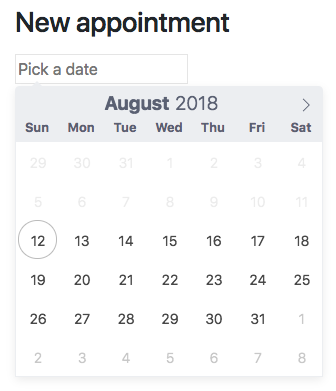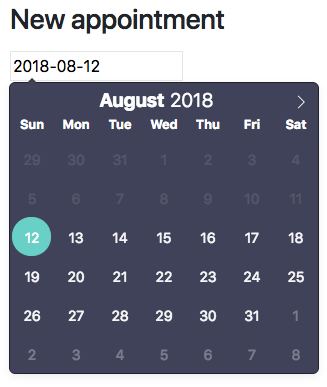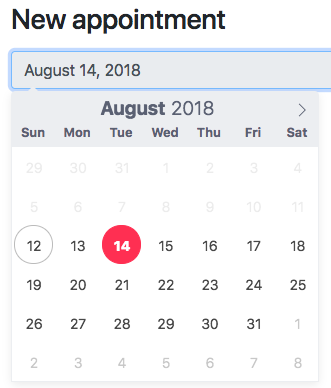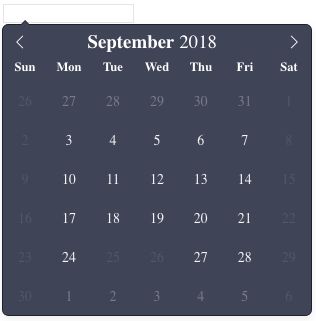Modest yet powerful wrapper of Flatpickr for Stimulus
Only ~1kb
- Simple: create advanced datepickers with less code
- Backend Friendly: easily pass backend information to the datepicker (locals, availabilities, date formats etc)
- strftime friendly: converts automatically strftime formats to flatpickr formating tokens
- Disable days of week: easily disable days of week (ie: all sundays)
- Turbolinks: make all your datepickers compatible with Turbolinks by design
- Getters: all Flatpickr elements are available as targets
- Events/hooks: all flatpickr events/hooks are directly available in your Stimulus Controller.
- Example: detailed example for adavanced usage of flatpickr
- MIT Licensed: free for personal and commercial use
By using this wrapper of Flatpickr for Stimulus you can make all configurations for the Datepicker directly with the data-attributes of the HTML. This makes it very handy to create datepicker with server generate html and pass information from the backend to the datepicker.
Here is a simple example:
<%= form_with model: Appointement.new, authenticity_token: true do |f| %>
<%= f.text_field :start_time,
data: {
controller: "flatpickr",
flatpickr_min_date: Time.zone.now #disables past dates
} %>
<% end %>👇👇👇👇👇👇
An example of a Rails app showcasing
- localization of the datepicker 🌍
- localization of the date formats 🌍
- availabilities in the date picker 📅
- Fully boosted with Turbolinks 🚀
is available here : Rails Stimulus Flatpickr
This assumes that you have Stimulus already installed. For Rails(5.1+) app please refer this doc (https://github.com/rails/webpacker/blob/master/docs/integrations.md#stimulus) to get started with Stimulus.
In your project just add the flatpickr and stimulus-flatpickr package.
$ yarn add flatpickr
$ yarn add stimulus-flatpickror
$ npm i flatpickr
$ npm i stimulus-flatpickrNote: Do not use both yarn and npm to install packages, this might lead to an error: ...It is advised not to mix package managers in order to avoid resolution inconsistencies caused by unsynchronized lock files
If you only need to convert an input field in a DateTime picker, you just need to register a standard Stimulus controller and add some markup to your input field.
manually register a new Stimulus controller in your main JS entry point.
// ./packs/application.js
import { Application } from 'stimulus'
import { definitionsFromContext } from 'stimulus/webpack-helpers'
const application = Application.start()
const context = require.context('../controllers', true, /\.js$/)
application.load(definitionsFromContext(context))
// import Flatpickr
import Flatpickr from 'stimulus-flatpickr'
// Import style for flatpickr
require("flatpickr/dist/flatpickr.css")
// Manually register Flatpickr as a stimulus controller
application.register('flatpickr', Flatpickr)Note:
- Setup: By Manually registering Flatpickr controller, you don't need to create a
flatpickr_controller.jsfile. However, To add custom behavior you will have to create theflatpickr_controller.jsfile. Read more details about it below. - Style: You can always choose different theme for calender by requiring different
.cssfile. You can find them inside your app's root directorynode_modules/flatpickr/dist/themes - Deployment: In Production environment, include
<%= stylesheet_pack_tag 'application', media: 'all', 'data-turbolinks-track': 'reload' %>in yourapplication.html.erbfile in order to load the calendar style.
You can now create forms and input fields easily by adding a data-controller="flatpickr" attribute to the input fields and pass options with the Stimulus Controller states : data-flatpickr-the-option.
<%= form_with model: Appointement.new, authenticity_token: true do |f| %>
<%= f.text_field :start_time,
data: {
controller: "flatpickr",
flatpickr_date_format: "Y-m-d",
flatpickr_min_date: Time.zone.now
} %>
<% end %>👇👇👇👇👇👇
All options for Flatpickr can be found here.
All options are in camelCase (JS) and must be converted to lower_snake_case in the data-attribute. lower_snake_case is automatically converted to kebab-case when rails render the HTML.
<%= f.text_field :start_time,
data: {
controller: "flatpickr",
flatpickr_enable_time: true
}
} %>will output this HTML:
<input data-controller="flatpickr" data-flatpickr-enable-time="true" type="text" name="appointement[start_time]" />If you are not using Rails or simply wants to markup your HTML directly, simply add a html data-controller="flatpickr" to your input field and some options html data-flatpickr-some-option="value" options must be converted from camelCase to kebab-case
If you need more than just displaying the standard DateTime picker, then you can extend the stimulus-flatpickr wrapper controller. This is necessary when you need to:
- set a custom language
- create custom callbacks
- perform JS business logic
Skip basics installation steps from above!
create a new Stimulus controller that will inherit from stimulus-flatpickr
// ./controllers/flatpickr_controller.js
// import stimulus-flatpickr wrapper controller to extend it
import Flatpickr from 'stimulus-flatpickr'
// you can also import a translation file
import { French } from 'flatpickr/dist/l10n/fr.js'
// import a theme (could be in your main CSS entry too...)
import 'flatpickr/dist/themes/dark.css'
// create a new Stimulus controller by extending stimulus-flatpickr wrapper controller
export default class extends Flatpickr {
initialize() {
// sets your language (you can also set some global setting for all time pickers)
this.config = {
locale: French
}
}
// all flatpickr hooks are available as callbacks in your Stimulus controller
change(selectedDates, dateStr, instance) {
console.log('the callback returns the selected dates', selectedDates)
console.log('but returns it also as a string', dateStr)
console.log('and the flatpickr instance', instance)
}
}As we have seen just above you can easily from your rails erb code pass the flatpickr options. This is great for passing dynamic options that might change (ie enableDate, dateFormat etc).
If all your datepickers share some global settings you can define them in your initialize() or connect() function.
initialize() {
//global options
this.config = {
enableTime: true,
time_24hr: true
};
}or with connect()
connect() {
//global options
this.config = {
...this.config, //spread options in case some where defined in initialize
enableTime: true,
time_24hr: true
};
//always call super.connect()
super.connect();
}Then in the same way as above you can now create forms and input fields easily by adding a data-controller="flatpickr" attribute to the input fields and pass options with the Stimulus Controller states : data-flatpick-the-option.
<%= form_with model: Appointement.new, authenticity_token: true do |f| %>
<%= f.text_field :start_time,
data: {
controller: "flatpickr",
flatpickr_date_format: "Y-m-d",
flatpickr_min_date: Time.zone.now }
%>
<% end %>👇👇👇👇👇👇
Flatpickr has custom formatting tokens. in Rails (and other backends) formats are based on strftime standard.
This package automatically converts strftime datetime formats to the nearest Flatpickr format.
With this solution, it becomes handy to localize your date formats. t("date.formats.long") outputs "%B %d, %Y"for the local :en and it outputs "%e %B %Y" for the locale :fr.
<%= form_with model: appointment do |f| %>
<%= f.text_field :start_at,
data: {
controller: "flatpickr",
flatpickr_alt_format: t("date.formats.long"),
flatpickr_alt_input: true,
flatpickr_min_date: Time.zone.now,
} %>
<% end %>👇👇👇👇👇👇
With Flatpickr to disable certain days of the week, you need to use the disable js function. Obviously passing a function through data-attributes is not easy 😄.
The wrapper introduce two new configuration options:
disableDaysOfWeek: pass an array of days to disable (all others are enabled)enableDaysOfWeek: pass an array of days to enable (all others are disabled)
| Code | Result |
|---|---|
<%= form_with model: Appointement.new, authenticity_token: true do |f| %>
<%= f.text_field :start_time,
data: {
controller: "flatpickr",
flatpickr_disable_days_of_week: [5,6], #disables saturdays and sundays
flatpickr_disable: ["2018-09-25", "2018-09-26"] #disables individual dates
} %>
<% end %>
|
All Flatpickr events/hooks are available as callbacks in the extended controller as demonstrated above for the onChange hook.
Just add the function to your Stimulus Controller in camelCase without on.
onChange -> change(){}
You can access the flatpickr instance from your Stimulus controller by calling this.fp. Also, the instance methods are available through this instance call.
yourFunction () {
// ...
this.fp.clear()
this.fp.close()
}If you want to display additional information on the calendar, you can wrap the Flatpickr controller arround custom elements. You can use the predefined target instance to attach the input element to the date picker.
Example:
<div data-controller="flatpickr">
<!-- the flatpicker instance -->
<input type="text" placeholder="Select Date.." data-flatpickr-target="instance" />
<!-- the custom element -->
<input type="text" data-flatpickr-target="custom" />
</div>In the stimulus controller, add the target:
static targets = ['custom']
yourFunction () {
//...
this.customTarget
}In your controller you can access the Flapickr elements using some Stimulus like targets.
this.calendarContainerTarget : Self-explanatory. This is the div.flatpickr-calendar element.
this.currentYearElementTarget: The input holding the current year.
this.daysTarget : The container for all the day elements.
this.daysContainerTarget : The container for all the day elements.
this.inputTarget : The text input element associated with flatpickr.
this.nextMonthNavTarget : The “right arrow” element responsible for incrementing the current month.
this.monthNavTarget : The container with the month navigation.
this.prevMonthNavTarget : The “left arrow” element responsible for decrementing the current month.
this.selectedDateElemTarget: the selected date element.
this.todayDateElemTarget: today element.
this.weekdayContainerTarget: the container we all the days of the week.
if you need to override the connect function in the extended controller, you need to call super
connect(){
// ...
// define global settings as explained in the global settings section before super
// ...
// always call super.connect()
super.connect();
// ...
// Your code can access this.fp flatpickr instance
// ...
}To handle multiple language to translate your datepicker and convert the date formats, you can have a look at the example app. stimulus-flatpickr makes it straight forward to handle locales.
This wrapper does not include any CSS. Flatpickr CSS should be loaded separately from the main Flatpickr package as you would normally do.
Bug reports and pull requests are welcome.
To contribute:
Fork the project.
Install dependencies
$ yarn install
Start the test watcher
$ yarn test:watch
Running one-off test runs can be done with:
$ yarn test
You can test locally also the results with the playground project ./playground
$ yarn start:playground
Then :
👍 Write some tests
💪 Add your feature
🚀 Send a PR
This package is available as open source under the terms of the MIT License.



